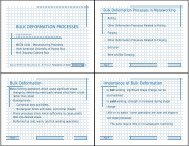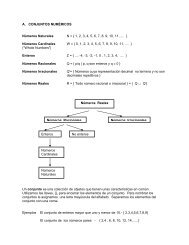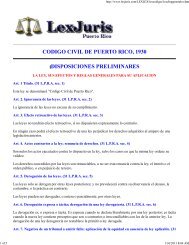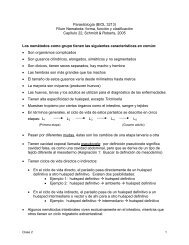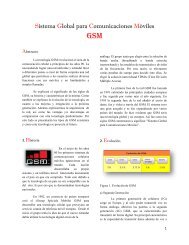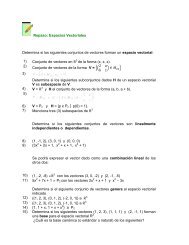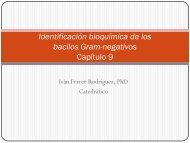Harmonically Excited Vibration
Harmonically Excited Vibration
Harmonically Excited Vibration
Create successful ePaper yourself
Turn your PDF publications into a flip-book with our unique Google optimized e-Paper software.
Chapter 3
• A mechanical system is said to undergo<br />
forced vibration whenever external energy is<br />
supplied to the system during vibration<br />
• External energy can be supplied to the<br />
system through either an applied force or an<br />
impose displacement excitation<br />
• The applied force or displacement may be<br />
harmonic, nonharmonic but periodic,<br />
nonperiodic, or random
• Harmonic or transient responses<br />
• Dynamic response of a single degree of<br />
freedom under harmonic excitations<br />
• Resonance<br />
• Examples: unbalanced rotating response, the<br />
oscillation of a tall chimney due to vortex<br />
shedding and the vertical motion of an<br />
automobile on a sinusoidal road surface
m x cx<br />
<br />
kx<br />
<br />
Ft<br />
<br />
Homogenous solution;<br />
m<br />
x <br />
cx<br />
<br />
kx<br />
0<br />
The solution;<br />
x h<br />
t<br />
chapter<br />
2<br />
This free vibration dies out with time under each of the three possible<br />
conditions of damping and under all possible initial conditions.
m x cx<br />
<br />
kx<br />
<br />
Ft<br />
<br />
Particular solution;<br />
x p<br />
t<br />
.....<br />
•The general solution<br />
eventually reduces to a<br />
particular solution x p (t), which<br />
represents the steady-state<br />
vibration<br />
•The steady-state motion is<br />
present as long as the forcing<br />
function
x<br />
h<br />
t<br />
<br />
m<br />
x<br />
<br />
C<br />
kx<br />
The homogeneous solution;<br />
<br />
F<br />
0<br />
cos t<br />
cos nt<br />
C2<br />
1<br />
<br />
sin<br />
<br />
n<br />
t<br />
The particular solution;<br />
x p<br />
t<br />
<br />
<br />
X<br />
cos<br />
<br />
t<br />
•The maximum amplitude of x p (t);<br />
X<br />
<br />
k<br />
F<br />
m<br />
0<br />
2<br />
<br />
<br />
<br />
st<br />
<br />
1 <br />
<br />
<br />
n<br />
<br />
2
m<br />
x<br />
kx<br />
<br />
F<br />
0<br />
cos t<br />
The total solution is;<br />
x<br />
h<br />
t<br />
<br />
<br />
C<br />
1<br />
F0<br />
cos nt<br />
C2<br />
sin nt<br />
<br />
2<br />
k m<br />
cos t<br />
Using the initial conditions x(t=0) = x 0 and v(t =0)=v 0<br />
C<br />
1<br />
<br />
x<br />
0<br />
<br />
k<br />
F0<br />
2<br />
m<br />
C<br />
2<br />
x<br />
0<br />
<br />
<br />
n
m<br />
x<br />
kx<br />
<br />
F<br />
0<br />
cos t<br />
The maximum amplitude can be<br />
expressed;<br />
X<br />
<br />
st<br />
<br />
1<br />
<br />
1<br />
<br />
<br />
n<br />
<br />
2<br />
Frequency ratio, r<br />
Magnification factor, amplitude ratio
m<br />
x<br />
kx<br />
<br />
F<br />
0<br />
cos t<br />
The response of the system can be<br />
identified to be of three types;<br />
Case 1:<br />
<br />
0 1,<br />
n<br />
thedenominator is<br />
positive<br />
The harmonic response is,<br />
x p<br />
t<br />
<br />
<br />
X<br />
cos t
m<br />
x<br />
kx<br />
<br />
F<br />
0<br />
cos t<br />
Case 2:<br />
<br />
1,<br />
n<br />
x p<br />
t<br />
<br />
thedenominator is<br />
The harmonic response is,<br />
X<br />
cos t<br />
negative<br />
X<br />
<br />
<br />
st<br />
2<br />
<br />
<br />
<br />
n<br />
<br />
1
m<br />
x<br />
Case 3:<br />
<br />
1,<br />
n<br />
x<br />
p<br />
t<br />
<br />
kx<br />
<br />
F<br />
0<br />
cos t<br />
theamplitude become infinite<br />
Resonance: the forcing<br />
frequency is equal to the<br />
natural frequency<br />
The harmonic response is,<br />
<br />
<br />
stnt<br />
2<br />
sin t<br />
n
m<br />
x<br />
kx<br />
<br />
F<br />
0<br />
cos t<br />
The response of the system at resonance becomes;<br />
x<br />
t<br />
<br />
<br />
x<br />
x <br />
0<br />
nt<br />
<br />
0<br />
cos sin<br />
nt<br />
<br />
<br />
n<br />
<br />
st<br />
t<br />
2<br />
n<br />
sin t<br />
n
m<br />
x<br />
kx<br />
<br />
F<br />
0<br />
cos t<br />
The total response of the system can also be expressed<br />
<br />
<br />
x( t)<br />
Acos<br />
n<br />
<br />
2<br />
<br />
n<br />
1<br />
<br />
<br />
n<br />
<br />
st<br />
<br />
t <br />
cos t;<br />
for 1<br />
<br />
<br />
x( t)<br />
Acos<br />
n<br />
<br />
2<br />
<br />
n<br />
1<br />
<br />
<br />
n<br />
<br />
st<br />
<br />
t <br />
cos t;<br />
for 1
• A weight of 50 N is suspended from a spring<br />
of stiffness 4000 N/m and is subjected to a<br />
harmonic force of amplitude 60 N and<br />
frequency 6 Hz. Find (a) the extension of the<br />
spring due to the suspended weight, (b) the<br />
static displacement of the spring due to the<br />
maximum applied force, and the amplitude of<br />
forced motion of the weight
• Consider a spring –mass system, with k=4000<br />
N/m and mass, m=10 kg, subject to a<br />
harmonic force F(t) = 400 cos 10 t N. Find the<br />
total response of the system under the<br />
following initial condition;<br />
• x 0 = 0.1m, v 0 = 0
• The spring actuator shown in the figure operates<br />
by using air pressure from a pneumatic<br />
controller (p) as input and providing an output<br />
displacement to a valve (x) proportional to the<br />
input air pressure. The diaphragm, made of a<br />
fabric-base rubber, has an area A and deflects<br />
under the input air pressure against a spring of<br />
stiffness k. Find the response of the valve under<br />
a harmonically fluctuating input air pressure<br />
p(t)=p 0 sinωt for the following data:<br />
• p 0 =10 psi, ω=8 rad/s, A=10 in 2 , k=400 lb/in, weight of<br />
spring = 15 lb, and weight of valve and valve rod = 20<br />
lb.
F<br />
t<br />
<br />
<br />
F<br />
0<br />
cos t<br />
m x cx<br />
<br />
kx<br />
<br />
F<br />
0<br />
cos t<br />
The particular solution;<br />
x p<br />
( t)<br />
<br />
X<br />
<br />
cos t<br />
<br />
<br />
X<br />
<br />
F<br />
<br />
2<br />
<br />
2 2 2 1/ 2<br />
k m c ]<br />
[ <br />
0<br />
<br />
tan<br />
1<br />
<br />
<br />
<br />
k<br />
c<br />
2<br />
m
Dividing X by k and substituting;<br />
m<br />
k<br />
n <br />
<br />
mk<br />
c<br />
m<br />
c<br />
c<br />
c<br />
n<br />
c 2<br />
2<br />
<br />
<br />
<br />
<br />
<br />
n<br />
m<br />
c<br />
2<br />
n<br />
r<br />
<br />
<br />
<br />
k<br />
F<br />
st<br />
0<br />
<br />
<br />
2<br />
2<br />
2<br />
2<br />
1/<br />
2<br />
2<br />
2<br />
2<br />
1<br />
1<br />
2<br />
1<br />
1<br />
r<br />
r<br />
X<br />
n<br />
st<br />
<br />
<br />
<br />
<br />
<br />
<br />
<br />
<br />
<br />
<br />
<br />
<br />
<br />
<br />
<br />
<br />
<br />
<br />
<br />
<br />
<br />
<br />
<br />
<br />
<br />
<br />
<br />
<br />
<br />
<br />
<br />
<br />
<br />
<br />
<br />
<br />
<br />
<br />
<br />
<br />
<br />
<br />
<br />
<br />
<br />
<br />
<br />
<br />
<br />
<br />
<br />
<br />
<br />
<br />
<br />
<br />
<br />
<br />
<br />
<br />
<br />
<br />
<br />
<br />
<br />
<br />
<br />
<br />
<br />
<br />
<br />
<br />
<br />
<br />
<br />
<br />
<br />
2<br />
1<br />
2<br />
1<br />
1<br />
2<br />
tan<br />
1<br />
2<br />
tan<br />
r<br />
r<br />
n<br />
n
• Some characteristics of the magnification<br />
factor;<br />
• Any amount of damping reduces the<br />
magnification factor<br />
• For any specified value of r, a higher value of<br />
damping reduces the value of M<br />
• In the degenerate case of a constant force (r=0),<br />
the value of M=1<br />
• The reduction in M in the presence of damping is<br />
very significant at or near resonance
• The amplitude of the forced vibration becomes<br />
smaller with increasing values of the forcing<br />
frequency ( that is M→0 as r → ∞)<br />
• For 0 ≤ ζ≤ 1/√2, the maximum value of M occurs<br />
when<br />
2<br />
2<br />
r 1<br />
2<br />
or 1<br />
2<br />
• The maximum value of X is<br />
n<br />
X<br />
<br />
<br />
st<br />
<br />
<br />
<br />
<br />
1<br />
max 2<br />
1<br />
<br />
2<br />
X<br />
<br />
<br />
st<br />
<br />
<br />
<br />
<br />
2<br />
<br />
n<br />
1
• For ζ= 1/√2, dM/dr =0 when r=0.<br />
• For ζ> 1/√2, the graph of M monotonically<br />
decrease with increasing r
• Some characteristics of the phase angle;<br />
• For an undamped system (ζ=0), the phase angle is<br />
0 for 0< r < 1 and 180° for r > 1. This implies that<br />
the excitation and the response are in phase for<br />
0 < r < 1 and out phase for r > 1<br />
• For ζ > 1 and 0 < r < 1, the phase angle is given by<br />
0 < φ < 90°, implying that the response lags the<br />
excitation<br />
• For ζ > 0 and r > 1, the phase angle is given by<br />
90° < φ < 180°, implying that response leads the<br />
excitation
• For ζ > 0 and r = 1, the<br />
phase angle is given by<br />
φ = 90°, implying that<br />
the phase difference<br />
between the excitation<br />
and the response is 90°<br />
• For ζ > 1 and large<br />
values of r, the phase<br />
angle approaches 180° ,<br />
implying that the<br />
response and excitation<br />
are out of phase
The complete solution, for an underdamped system,<br />
x<br />
<br />
<br />
t<br />
t X e <br />
t <br />
<br />
X t<br />
<br />
n<br />
cos<br />
0<br />
cos<br />
d 0<br />
For the initial condition, xt<br />
0 x0 and x<br />
t<br />
0 x<br />
0<br />
x<br />
x<br />
0<br />
0<br />
<br />
X<br />
0<br />
<br />
X<br />
cos<br />
X cos<br />
n<br />
0<br />
0<br />
cos<br />
<br />
X<br />
0<br />
d<br />
cos<br />
X<br />
sin<br />
X <br />
<br />
<br />
st<br />
2 2<br />
1 r 2r<br />
2<br />
tan<br />
1<br />
2r<br />
<br />
1<br />
r<br />
2<br />
<br />
<br />
<br />
X<br />
<br />
2<br />
2<br />
X cos X <br />
1/ 2<br />
0<br />
<br />
0 0 0<br />
sin<br />
0<br />
tan<br />
0<br />
<br />
X<br />
X<br />
0<br />
0<br />
sin0<br />
cos<br />
0
• For a vibrating system, m = 10 kg, k = 2500<br />
N/m, and c = 45 N-s/m. A harmonic force 180<br />
N and frequency 3.5 Hz acts on the mass. If<br />
the initial displacement and velocity of the<br />
mass are 15mm and 5 m/s, find the complete<br />
solution representing the motion of the mass.
The quality factor, Q, is the value of<br />
the of the amplitude ratio at<br />
resonance.<br />
For small values of damping, (ζ
The difference between the frequencies<br />
associated with the half power points is<br />
called bandwidth<br />
2 2<br />
<br />
1<br />
R1 r1<br />
<br />
1<br />
<br />
<br />
n <br />
2<br />
2<br />
2 2<br />
<br />
2<br />
R2 r2<br />
<br />
1<br />
<br />
<br />
n <br />
2<br />
2<br />
<br />
2 1<br />
2 n<br />
1 n<br />
Q <br />
2<br />
<br />
2<br />
1
The harmonic forcing function can be represented<br />
in complex form as F(t)=F 0 e iωt<br />
mx cx<br />
<br />
kx<br />
<br />
Fe<br />
it<br />
Assuming the particular solution;<br />
x<br />
p<br />
t<br />
<br />
<br />
Xe<br />
it<br />
F0<br />
X <br />
<br />
2<br />
k m ic<br />
<br />
<br />
X<br />
<br />
<br />
2<br />
k m<br />
F<br />
0<br />
<br />
2<br />
1/ 2<br />
<br />
2 2<br />
c <br />
<br />
e<br />
i<br />
<br />
tan<br />
1<br />
<br />
<br />
<br />
k<br />
c<br />
2<br />
m
The steady-state solution;<br />
F<br />
<br />
0<br />
xp<br />
t <br />
1/ 2<br />
2 2 2 2<br />
k m<br />
c <br />
<br />
<br />
<br />
<br />
e<br />
<br />
i t<br />
<br />
The Frequency Response,<br />
F0<br />
X <br />
<br />
2<br />
k m ic<br />
<br />
<br />
kX<br />
F<br />
0<br />
<br />
1<br />
r<br />
2<br />
1<br />
i2r<br />
<br />
H<br />
<br />
i<br />
<br />
Hi<br />
complex frequency response
The Frequency Response,<br />
The absolute value ,<br />
H<br />
F<br />
<br />
<br />
i<br />
<br />
kX<br />
F<br />
<br />
1<br />
<br />
2 2<br />
2<br />
1<br />
r r<br />
1/ 2<br />
0 2<br />
<br />
<br />
<br />
<br />
i t<br />
t H i e<br />
0<br />
xp<br />
k<br />
F0 it<br />
<br />
<br />
velocity x<br />
pt<br />
i<br />
Hi<br />
e<br />
ix<br />
p(<br />
t)<br />
k<br />
2 F0<br />
it<br />
<br />
2<br />
accel. xpt<br />
i<br />
Hi<br />
e<br />
<br />
xp(<br />
t)<br />
k
• The figure shows a simple model of a motor<br />
vehicle that can vibrate in the vertical direction<br />
while traveling over a rough road. The vehicle<br />
has a mass of 1200 kg. The suspension system<br />
has a spring constant of 400 kN/m and a<br />
damping ratio of 0.5. If the vehicle speed is 20<br />
km/hr, determine the displacement amplitude of<br />
the vehicle. The road surface varies sinusoidally<br />
with an amplitude of Y = 0.05 m and a<br />
wavelength of 6m.
0<br />
)<br />
(<br />
)<br />
( <br />
<br />
<br />
<br />
<br />
y<br />
x<br />
k<br />
y<br />
x<br />
c<br />
x<br />
m<br />
<br />
<br />
<br />
<br />
<br />
<br />
<br />
<br />
y<br />
c<br />
ky<br />
kx<br />
cx<br />
x<br />
m<br />
<br />
<br />
<br />
2<br />
2<br />
c<br />
k<br />
Y<br />
A<br />
<br />
<br />
<br />
<br />
<br />
<br />
<br />
<br />
k<br />
c<br />
<br />
1<br />
tan<br />
t<br />
Y<br />
t<br />
y<br />
<br />
sin<br />
)<br />
(<br />
if<br />
<br />
<br />
<br />
t<br />
Y<br />
c<br />
t<br />
kY<br />
<br />
<br />
sin cos<br />
<br />
<br />
<br />
<br />
t<br />
Asin
The steady state response of the mass,<br />
x p<br />
<br />
<br />
2<br />
<br />
2<br />
k m<br />
c<br />
<br />
<br />
2<br />
Y k c<br />
( t)<br />
sint<br />
1<br />
<br />
<br />
2 1/ 2<br />
[<br />
]<br />
2<br />
1 tan<br />
1<br />
<br />
<br />
<br />
k<br />
c<br />
2<br />
m<br />
<br />
<br />
<br />
tan<br />
1<br />
c <br />
<br />
k
The response can be rewritten as,<br />
x p<br />
( t)<br />
<br />
Asin<br />
<br />
t<br />
<br />
<br />
Displacement transmissibility,<br />
X<br />
Y<br />
<br />
<br />
<br />
<br />
k<br />
2<br />
<br />
2 2<br />
k<br />
m<br />
c<br />
<br />
<br />
c<br />
<br />
2<br />
2<br />
<br />
<br />
<br />
1<br />
2<br />
<br />
<br />
<br />
<br />
1<br />
<br />
2r<br />
<br />
2 2<br />
1<br />
r 2r<br />
<br />
2<br />
2<br />
<br />
<br />
<br />
1/ 2<br />
<br />
tan<br />
1<br />
<br />
<br />
<br />
k<br />
<br />
3<br />
3<br />
mc<br />
<br />
<br />
<br />
<br />
1<br />
2r<br />
tan<br />
2 2<br />
2 2<br />
k m<br />
c<br />
1<br />
4<br />
1r
The harmonic excitation of the base expressed in complex<br />
form as<br />
y(<br />
t)<br />
The response of the system ,<br />
Re( Ye<br />
it<br />
)<br />
x<br />
<br />
1<br />
i2r<br />
Re<br />
1<br />
r i2r<br />
p( t)<br />
2<br />
<br />
Ye<br />
<br />
it<br />
<br />
<br />
<br />
X<br />
Y<br />
<br />
T<br />
d<br />
<br />
<br />
2 1/ 2<br />
1 2r<br />
Hi
• Some characteristics of the displacement<br />
transmissibility;<br />
• The value of T d is unity at r=0 and close to unity for<br />
small value of r<br />
• For an undamped system (ζ=0), T d →∞ at<br />
resonance (r=1)<br />
• The value of T d is less than unity for values r > √2<br />
• The value of T d =1 for all values of ζ at r= √2<br />
• For r< √2, smaller damping ratio lead to larger<br />
values of T d .
• Some characteristics of the displacement<br />
transmissibility;<br />
• For r> √2, smaller damping ratio lead to smaller<br />
values of T d<br />
• T d attains a maximum for 0
A force is transmitted to the base<br />
or support due to the reaction from<br />
the spring and the dashpot,<br />
F<br />
<br />
k<br />
x<br />
y<br />
cx<br />
y<br />
mx<br />
2<br />
F m<br />
X<br />
sin<br />
Force transmissibility,<br />
t<br />
F t<br />
<br />
T sin<br />
F T<br />
kY<br />
<br />
r<br />
2<br />
<br />
<br />
<br />
1<br />
<br />
2r<br />
<br />
<br />
2<br />
<br />
2<br />
1<br />
r 2r<br />
<br />
2<br />
2<br />
<br />
<br />
<br />
1/ 2
Force transmissibility,<br />
F T<br />
kY<br />
<br />
r<br />
2<br />
<br />
<br />
<br />
1<br />
<br />
2r<br />
<br />
<br />
2<br />
<br />
2<br />
1<br />
r 2r<br />
<br />
2<br />
2<br />
<br />
<br />
<br />
1/ 2
Relative Motion, z = x – y,<br />
m<br />
x cz<br />
<br />
kz<br />
my<br />
<br />
<br />
2<br />
m<br />
Y<br />
sint<br />
z<br />
t<br />
<br />
<br />
<br />
2<br />
m<br />
Y<br />
2<br />
<br />
2<br />
k m<br />
c<br />
<br />
Z<br />
sin<br />
<br />
sin<br />
t<br />
<br />
<br />
1<br />
t<br />
<br />
<br />
2<br />
<br />
<br />
1/ 2
Relative Motion, z = x – y,<br />
Z <br />
2<br />
m<br />
Y<br />
Y<br />
2 2 2<br />
2 2<br />
k<br />
m<br />
c<br />
1 r 2r<br />
2<br />
r<br />
2<br />
<br />
1<br />
tan<br />
1<br />
<br />
<br />
<br />
k<br />
c<br />
2<br />
m<br />
<br />
<br />
<br />
<br />
tan<br />
1<br />
2r<br />
<br />
1<br />
r<br />
2
• The figure shows a simple model of a motor<br />
vehicle that can vibrate in the vertical direction<br />
while traveling over a rough road. The vehicle<br />
has a mass of 1200 kg. The suspension system<br />
has a spring constant of 400 kN/m and a<br />
damping ratio of 0.5. If the vehicle speed is 20<br />
km/hr, determine the displacement amplitude of<br />
the vehicle. The road surface varies sinusoidally<br />
with an amplitude of Y = 0.05 m and a<br />
wavelength of 6m.
• A heavy machine, weighing 3000 N supported<br />
on a resilient foundation. The static deflection of<br />
the foundation due to the weight of the machine<br />
is found to be 7.5 cm. It is observed that the<br />
machine vibrates with an amplitude of 1 cm<br />
when the base of the foundation is subjected to<br />
harmonic oscillation at the undamped natural<br />
frequency of the system with an amplitude of<br />
0.25 cm. Find (a) the damping constant of the<br />
foundation, (b) the dynamic force amplitude on<br />
the base, and (c) the amplitude of the of the<br />
machine relative to the base.
• A precision grinding machine is supported on an<br />
isolator that has a stiffness of 1 MN/m and a<br />
viscous damping constant of 1 kN-s/m. The floor<br />
on which the machine is mounted is subjected to<br />
a harmonic disturbance due to the operation of<br />
an unbalanced engine in the vicinity of the<br />
grinding machine. Find the maximum<br />
acceptable displacement amplitude of the floor<br />
if the resulting amplitude of vibration of the<br />
grinding wheel is to be restricted to 10 -6 m.<br />
Assume that the grinding machine and the<br />
wheel are a rigid body of weight 5000 N
• One of the tail rotor blades of a helicopter has<br />
an unbalanced mass of m=0.5 kg at a distance<br />
of e = 0.15 m from the axis of rotation , as<br />
shown in the figure. The tail section has a<br />
length of 4 m, a mass of 240 kg, a flexural<br />
stiffness (EI) of 2.5 MN – m 2 , and a damping<br />
ratio of 0.15. The mass of the tail rotor blades,<br />
including their drive system, is 20 kg.<br />
Determine the forced response of the tail<br />
section when the blades rotate at 1500 rpm
F<br />
t<br />
<br />
<br />
2<br />
me sin t<br />
2<br />
M x cx<br />
kx<br />
me sint<br />
The particular solution;<br />
x<br />
p<br />
( t)<br />
<br />
X<br />
<br />
Im<br />
<br />
sin<br />
<br />
me<br />
M<br />
t<br />
<br />
<br />
<br />
<br />
n<br />
<br />
<br />
2<br />
H<br />
<br />
it<br />
<br />
i<br />
e
i<br />
H<br />
M<br />
me<br />
c<br />
M<br />
k<br />
me<br />
X<br />
n<br />
<br />
<br />
<br />
<br />
<br />
<br />
<br />
<br />
<br />
<br />
<br />
<br />
2<br />
1/<br />
2<br />
2<br />
2<br />
2<br />
2<br />
]<br />
[<br />
<br />
<br />
<br />
<br />
<br />
<br />
<br />
<br />
<br />
2<br />
1<br />
tan<br />
<br />
<br />
<br />
M<br />
k<br />
c<br />
<br />
<br />
<br />
<br />
<br />
<br />
<br />
i<br />
H<br />
r<br />
r<br />
r<br />
r<br />
me<br />
MX 2<br />
2<br />
2<br />
2<br />
2<br />
2<br />
1<br />
<br />
<br />
<br />
<br />
<br />
<br />
<br />
<br />
<br />
<br />
<br />
<br />
<br />
2<br />
1<br />
1<br />
2<br />
tan<br />
r<br />
r
• The following observation can be made from<br />
the equations;<br />
• All the curves begin at zero amplitude. The<br />
amplitude near resonance is markedly affected by<br />
damping. Thus if the machine is to be run near<br />
resonance, damping should be introduced<br />
purposefully to avoid dangerous amplitudes.<br />
• At very high speeds(ω large), MX/me is almost<br />
unity, and the effect of damping is negligible.
• The following observation can be made from<br />
the equations;<br />
• For 0 < ζ < 1 /√2, the maximum of MX/me is<br />
<br />
<br />
<br />
MX<br />
me<br />
<br />
<br />
<br />
<br />
1<br />
max 2 1<br />
<br />
2<br />
▪ The peaks occur to the right of the resonance value r=1<br />
• Forζ > 1 /√2, MX/me does not attain a maximum.<br />
Its value grows from 0 at r=0 to 1 at r→∞.






